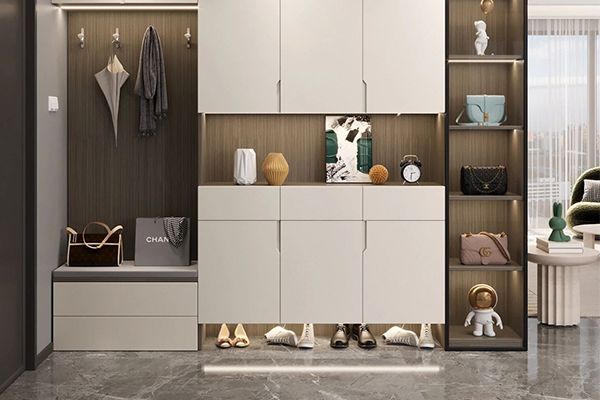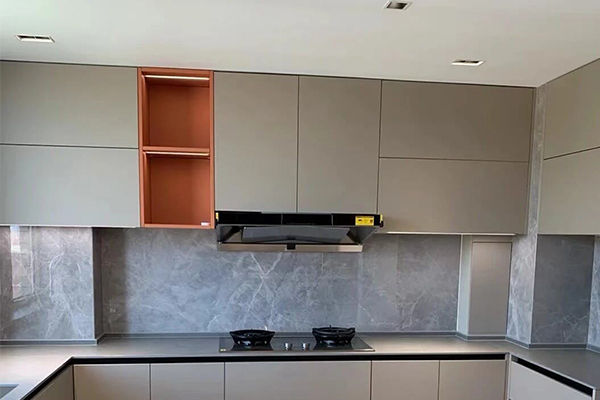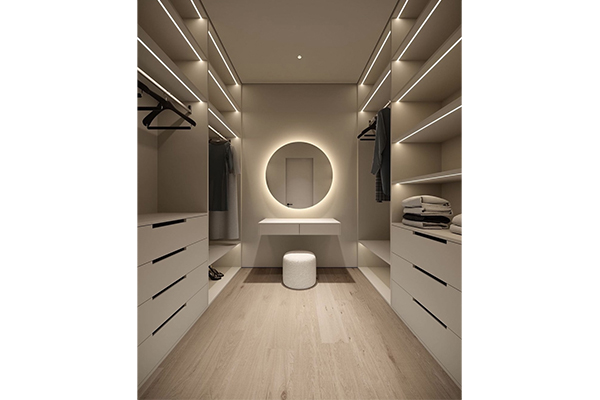How to maximize the use of every inch of space in kitchen cabinets?
Release Time : 2025-07-07
The kitchen is one of the most frequently used areas in family life, and the cabinet, as the core storage system of the kitchen, directly affects the cooking efficiency and quality of life. With the compactness of modern residential space, how to achieve efficient storage and improve utilization in a limited space has become an important topic in kitchen design.
1. Scientific and reasonable layout design is the basis
The space utilization rate of kitchen cabinets depends first on whether the overall layout design is reasonable. Common kitchen layouts include "one-line", "L-shaped", "U-shaped", "island-shaped", etc. Each layout should be customized according to the actual apartment type and usage habits.
For example, the "L-shaped" layout is suitable for small and medium-sized apartments. The worktop and storage space can be increased through reasonable planning at the corners; the "U-shaped" layout is more suitable for large kitchens, which can make full use of three walls to create sufficient cabinet space; and the design with an island not only increases the storage area, but also can be used as a meal preparation or dining area.
2. Multi-layer partition design improves internal space efficiency
The refined partitioning of the internal structure of the cabinet is the key to improving space utilization. An excellent cabinet is often divided into multiple functional areas:
Upper wall cabinet: used to store infrequently used items, such as holiday tableware, spare spice jars, etc.
Middle floor cabinet: close to the workbench, suitable for placing commonly used kitchen utensils and pots for easy access;
Lower drawer: adopts pull-out basket or compartment drawer design, which can be classified to store tableware, knives, small tools, etc.;
Corner cabinet: Traditional corner space is prone to dead corners, but through the design of rotating pull-out baskets and inclined pull-out drawers, these "blind spots" can be transformed into practical storage space. In addition, some high-end cabinets will also be equipped with functional accessories such as lifting pull-out baskets, folding racks, and flap door storage systems to further tap the potential inside the cabinet.
3. Use vertical space to create an "upward development" storage system
When the kitchen area is limited, making full use of vertical space is an effective way to improve storage capacity. The height of the wall cabinet can be appropriately extended to a position close to the ceiling, which can not only accommodate more items, but also reduce the problem of dust accumulation on the top.
At the same time, wall space can also be cleverly used. For example, installing hooks, magnetic knife racks, racks and other accessories, hanging some small tools on the wall, saving space and making it easy to take. For tall cabinets, you can also consider setting up lifting storage racks to easily store and access high-rise items through mechanical or electric devices.
4. Smart hardware accessories help efficient storage
Modern kitchen cabinets are no longer simple wooden cabinets. More and more intelligent hardware accessories are used in them, which greatly improves space utilization and convenience of use:
Damping hinges and static slide rails: ensure smooth opening and closing of cabinet doors, silent closing, and increase service life;
Electric lifting cabinets: a light press can automatically raise items hidden in wall cabinets, especially suitable for the elderly and children;
Rotating pull-out baskets and turntables: suitable for corner cabinets and floor cabinets, so that deep items can also be easily reached;
Multifunctional drawer system: drawers with partitions and adjustable height to meet the storage needs of items of different sizes. These smart accessories not only improve the functionality of cabinets, but also make space utilization more humane and efficient.
5. Color and lighting design create a sense of visual expansion
In addition to functional design, the color matching and lighting design of the cabinets also affect the perception of space to a certain extent. Light colors (such as white, beige, and light gray) can reflect more light, making the kitchen look brighter and more spacious; while dark colors are suitable for local embellishment to enhance the texture and layering.
In addition, installing LED light strips under the wall cabinets can not only provide additional lighting, but also visually expand the sense of space and avoid the sense of oppression caused by shadows.
Kitchen cabinets are not only the embodiment of the beauty of the kitchen, but also the core of function and efficiency. Through scientific layout design, fine internal division, full development of vertical space, and the application of intelligent hardware accessories, it is completely possible to "not waste every inch of space". Whether it is an open kitchen or a small space, as long as you plan carefully, you can create an efficient kitchen environment that is both practical and beautiful.
1. Scientific and reasonable layout design is the basis
The space utilization rate of kitchen cabinets depends first on whether the overall layout design is reasonable. Common kitchen layouts include "one-line", "L-shaped", "U-shaped", "island-shaped", etc. Each layout should be customized according to the actual apartment type and usage habits.
For example, the "L-shaped" layout is suitable for small and medium-sized apartments. The worktop and storage space can be increased through reasonable planning at the corners; the "U-shaped" layout is more suitable for large kitchens, which can make full use of three walls to create sufficient cabinet space; and the design with an island not only increases the storage area, but also can be used as a meal preparation or dining area.
2. Multi-layer partition design improves internal space efficiency
The refined partitioning of the internal structure of the cabinet is the key to improving space utilization. An excellent cabinet is often divided into multiple functional areas:
Upper wall cabinet: used to store infrequently used items, such as holiday tableware, spare spice jars, etc.
Middle floor cabinet: close to the workbench, suitable for placing commonly used kitchen utensils and pots for easy access;
Lower drawer: adopts pull-out basket or compartment drawer design, which can be classified to store tableware, knives, small tools, etc.;
Corner cabinet: Traditional corner space is prone to dead corners, but through the design of rotating pull-out baskets and inclined pull-out drawers, these "blind spots" can be transformed into practical storage space. In addition, some high-end cabinets will also be equipped with functional accessories such as lifting pull-out baskets, folding racks, and flap door storage systems to further tap the potential inside the cabinet.
3. Use vertical space to create an "upward development" storage system
When the kitchen area is limited, making full use of vertical space is an effective way to improve storage capacity. The height of the wall cabinet can be appropriately extended to a position close to the ceiling, which can not only accommodate more items, but also reduce the problem of dust accumulation on the top.
At the same time, wall space can also be cleverly used. For example, installing hooks, magnetic knife racks, racks and other accessories, hanging some small tools on the wall, saving space and making it easy to take. For tall cabinets, you can also consider setting up lifting storage racks to easily store and access high-rise items through mechanical or electric devices.
4. Smart hardware accessories help efficient storage
Modern kitchen cabinets are no longer simple wooden cabinets. More and more intelligent hardware accessories are used in them, which greatly improves space utilization and convenience of use:
Damping hinges and static slide rails: ensure smooth opening and closing of cabinet doors, silent closing, and increase service life;
Electric lifting cabinets: a light press can automatically raise items hidden in wall cabinets, especially suitable for the elderly and children;
Rotating pull-out baskets and turntables: suitable for corner cabinets and floor cabinets, so that deep items can also be easily reached;
Multifunctional drawer system: drawers with partitions and adjustable height to meet the storage needs of items of different sizes. These smart accessories not only improve the functionality of cabinets, but also make space utilization more humane and efficient.
5. Color and lighting design create a sense of visual expansion
In addition to functional design, the color matching and lighting design of the cabinets also affect the perception of space to a certain extent. Light colors (such as white, beige, and light gray) can reflect more light, making the kitchen look brighter and more spacious; while dark colors are suitable for local embellishment to enhance the texture and layering.
In addition, installing LED light strips under the wall cabinets can not only provide additional lighting, but also visually expand the sense of space and avoid the sense of oppression caused by shadows.
Kitchen cabinets are not only the embodiment of the beauty of the kitchen, but also the core of function and efficiency. Through scientific layout design, fine internal division, full development of vertical space, and the application of intelligent hardware accessories, it is completely possible to "not waste every inch of space". Whether it is an open kitchen or a small space, as long as you plan carefully, you can create an efficient kitchen environment that is both practical and beautiful.







